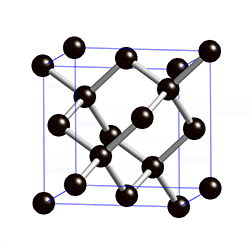
February Editorial
Melting diamonds

February Editorial
Melting diamonds
|
|
Diamonds are the most coveted of stones and for good reason. Jewellery aside, diamonds have exceptional physical qualities. Diamond is the hardest of all known materials and it has the highest thermal conductivity. Those properties are due to the strong covalent bonding between a diamond's carbon atoms and they are exploited in number of industrial applications, primarily in cutting and polishing tools. |
|
|
But although they are hard nuts to crack when compared to other materials, relatively little is known about the properties of diamonds under extreme conditions. Recently this gap in our knowledge has been addressed by researchers at the Lawrence Livermore National Laboratory (LLNL). They used two lasers: the Janus laser at their facilities and secondly, the Omega laser at the University of Rochester. The natural diamond crystals were treated by the lasers to shock-wave compressions of between 1 million to 10 million atmospheres of pressure. The experiment showed that diamonds show considerable strength up to the point of melt (which was at almost a million times atmospheric pressure). However, once they reached the melting point the diamonds were crushed and melted in just a nanosecond (one billionth of a second). These results have practical implications because high-density carbon, which is essentially a diamond, is a leading candidate for use in nuclear fusion (As target capsules, containing isotopes, for example of hydrogen). So knowing the exact behaviour of diamonds under extreme stress will help in planning fusion experiments. The research from LLNL can also help us in understanding the environment in the interior of the gas giants as well as inside our own planet. We know that here on Earth, diamonds are formed under high-pressure, high-temperature conditions at depths of 87 to 120 miles into the Earth's mantle. Carbon containing minerals which disintegrate under these conditions provides the source of carbon from which diamond crystals slowly grow over a period from 1 to 3.3 billion years. But diamonds are not restricted to Earth. Indeed even here on Earth, we can find diamonds of extraterrestrial origin, probably deposited during asteroid impacts some 3 billion years ago. An example of this sort of diamond could be the carbonado found in South America and Africa. Carbonado, commonly known as the "Black Diamond", is a natural polycrystalline (containing many crystallites of different sizes) diamond. Its natural colour is black or dark grey, and it is more porous than other diamonds. There is evidence that white dwarf stars have a core of crystallized carbon and oxygen nuclei. The largest of those and the best known is Lucy which is believed to have a diamond stellar core which is some 4000 km wide. Earlier research from the LLNL focused on reproducing conditions on the icy gas giant planets (Uranus and Neptune) where, according to their research, icebergs of diamond could float on a sea of liquid carbon. Reference:
| |
| _______________________________ | ||||
| Home | | | Shopping | | | Database |
© Biscuit Software 2004-2015
All rights reserved